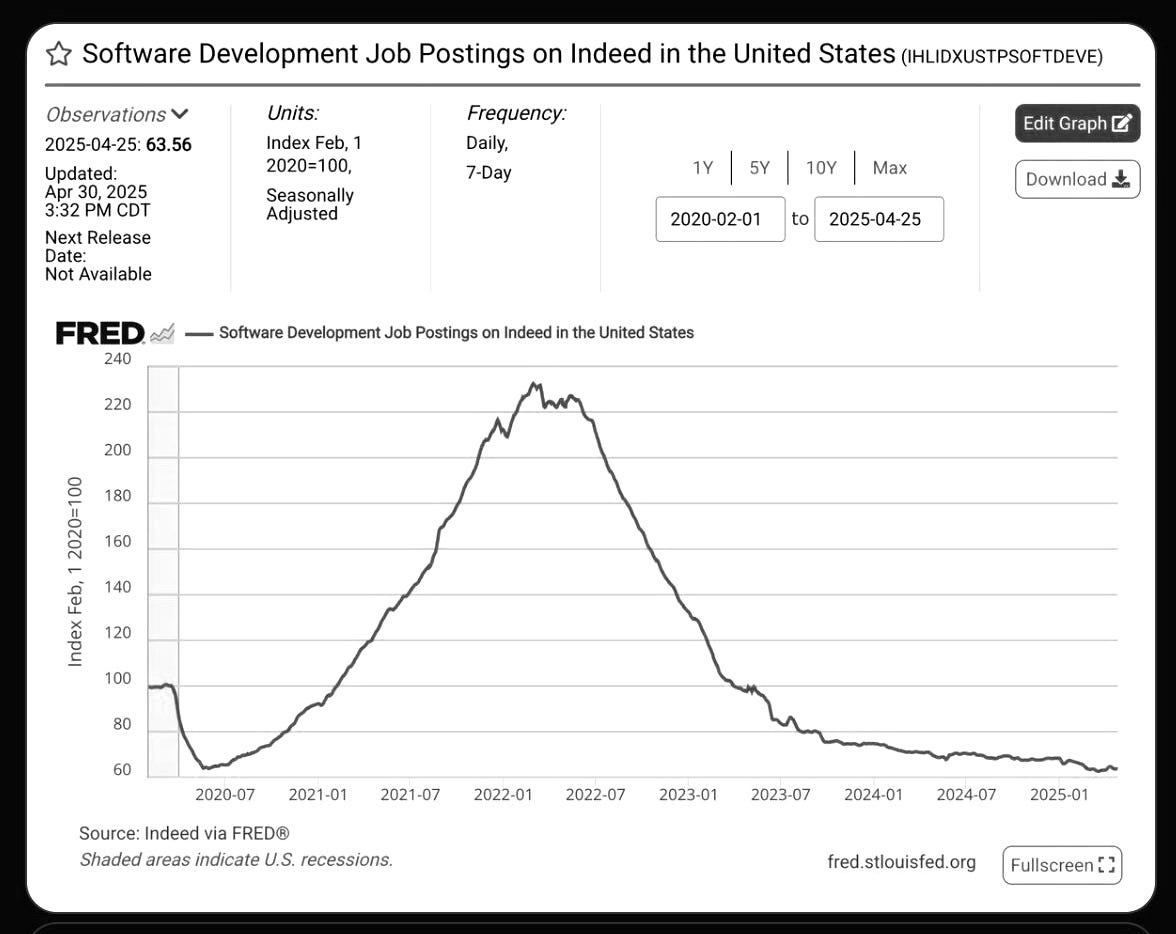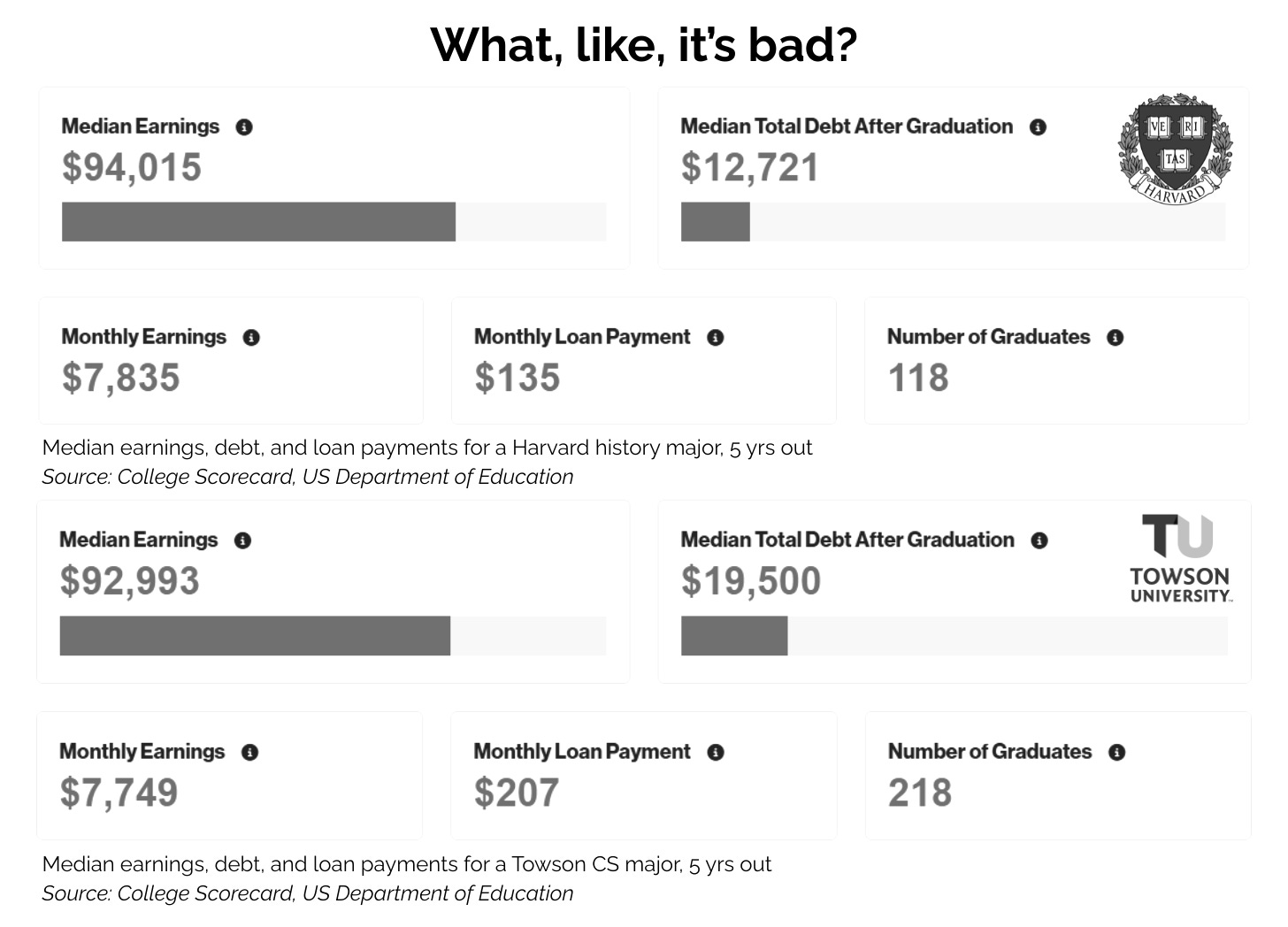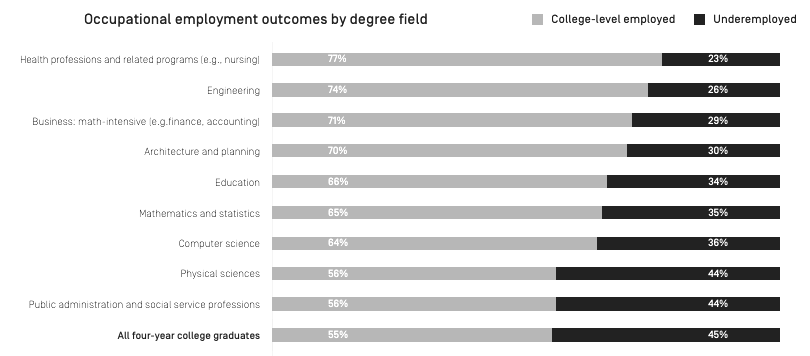The headlines are seductive: The 50 Most Economically Disastrous College Majors. Such lists go viral on social feeds, stir debates, and subtly shape enrollment patterns. But while we argue over whether Art History or Anthropology deserves worst-place spot, the very ground beneath traditional ROI logic is shifting. AI is gutting once-safe STEM entry points. Institutional prestige—not field of study—is quietly driving the long tail of economic outcomes. And non-STEM majors from top-tier schools are outperforming mid-tier CS grads.
The real question isn’t which major to study, or to cut. It’s whether the programs are positioned for a labor market being reordered by automation, access, and brand.
The Illusion of Safety in STEM
Computer Science has long functioned as the safety school of academic disciplines: a guaranteed ticket to high-salary, high-demand employment. But that assumption is now colliding with reality. Entry-level tech roles are being restructured or eliminated altogether, not because demand is falling, but because AI is absorbing foundational tasks: debugging, basic coding, test generation.
Between 2023 and 2024, programmer job postings fell 9%. Coding bootcamps closed. Satya Nadella at Microsoft says 20-30% of its code is now AI-generated. One experienced engineer using Copilot can now match the productivity of three. These shifts are not theoretical. They are labor market signals that have yet to price in.
And that’s the risk: promising students a reliable tech outcome while the entry-level rung is being sawed off beneath them.

AI and the Rise of the Generalist Strategist
AI is not just a threat to technical roles, it's altering what skill sets the market rewards. The most valuable employees now are not pure coders, but AI-literate architects, orchestrators, and problem-solvers. TD Bank, JPMorgan, and others are now hiring for abstraction, not execution. Prompt engineers, product strategists, and systems thinkers are in; basic coders are out.
This should provoke uncomfortable questions: Are your programs training students for skills that machines will subsume? Are your marketing messages aligned with the actual demands of the labor market? Have you updated your definitions of “job readiness” beyond legacy placement stats?
Several institutions are quietly doing exactly this, with our help. Reach out, let’s talk.

Prestige Outpaces Major
Rankings such as Anand Sanwal’s (CB Insights founder and someone I admire) The 50 Most Economically Disastrous College Majors that reduce educational ROI to major-specific earnings obscure a more powerful reality: institutional capital can do a lot of heavy lifting. Philosophy majors from highly selective institutions routinely out-earn engineering graduates from non-selective institutions. Not because the content is more marketable, but because the institution provides the scaffolding—brand, network, employer access, and cultural signaling—that drives outcomes.
Opportunity Insights, a think tank at Harvard, found that Ivy+ attendance across all majors increases the likelihood of reaching the top 1% by 60%.
Early career data suggests humanities and social sciences grads from the top-tier earn comparable salaries to STEM grads from lower-tier universities.

Meanwhile, even humanities and social sciences grads from top-tier schools accelerate their earnings mid-career. Payscale data shows a $60K gap in mid-career salaries between Ivy grads and everyone else. After 20 years of work experience, the median salary across majors for non-Ivy League graduates is $102K, while for Ivy League graduates it’s $162K. That’s a 37% advantage for graduates of top-tier schools!
In comparison, the median mid-career salary across all universities for a Computer Science graduate is $115K while for a Political Science graduate is $90K (Federal Reserve Bank of New York). That’s only a 28% percent difference.
When you factor in access to graduate programs, top-tier employers, and elite networks, the compound advantage of attending a top-tier school becomes self-reinforcing.
If your institution isn’t offering prestige, it must offer outcomes. If it offers neither, the enrollment and reputation consequences are downstream.
Underemployment Doesn’t Just Hit the Liberal Arts
Another familiar critique of liberal arts degrees is underemployment. But the data tells a more nuanced story. Computer Science majors have higher underemployment rate than Education majors, according to Burning Glass and Strada’s excellent report Talent Disrupted (2024). Yet, Education-related majors are a favorite punching bag, and accounted for 5 out of 50 of Sanwal’s Top 50 Economically Disastrous Majors.
Without brand prestige or applied experience (internships, capstone projects, alumni referrals), even CS majors are liable to be underemployed.

Program Strategy in an Asymmetric Labor Market
Payscale reports the two highest-paying jobs held by a majority of individuals holding bachelors’ degrees only, are ‘Media Director’ and ‘Director of Digital Marketing’—perfectly viable for graduates from almost any field of study and especially true for majors related to arts, media and communications. Yet these very fields feature prominently at the top of Sanwals' list of villainous majors to avoid.
If you're building or revising academic programs, the path forward isn’t just about adding AI electives or cutting low-earning majors. It's about identifying where your institution has durable signaling power and where it must build differentiated value through partnerships, delivery models, or experiential layers such as internships.
Ask: Which programs produce outcomes that outpace our brand tier? Which overpromise and quietly underdeliver? What skills are defensible against automation and translatable across careers? These are not academic questions. They are reputational ones.
If you're seeing persistent drag in your graduates’ early career outcomes—or if your graduates are struggling to cross into high-skill roles—the root cause may not be student aptitude but structural misalignment of your institutions’ connectivity with employer needs, hiring ecosystems, and professional graduate programs.
There are asymmetric opportunities for graduates from a wide assortment of majors and institutions to do well. We’ve worked with institutions to map program-level signaling strength against market dynamics—and used that to guide portfolio realignment, industry engagement, and new program development. If that’s a conversation you’re having, or need to be, let’s talk.
Final Thought
The debate over "disastrous" majors misses the point.
While major selection has undeniable economic consequences, it’s only one of several levers. It’s critical to ensure that your institution is aligned with the new logic of value: AI resilience, network effects, brand credibility, and adaptive capacity.
If you're ready to reframe how your institution competes on outcomes, brand, and future-readiness, we're having quiet conversations with leaders navigating these same transitions.
Reach out. We’ll share what we’re seeing.







